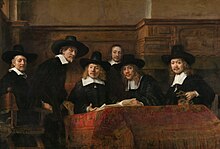Dorothy Creole
[2] Property of the Dutch West India Company, these women were brought to the colony to become the wives of enslaved African men who had arrived in 1625.
[3] It was also the year of the supposed sale of the island of Manhattan to the Dutch by native inhabitants for the equivalent of 24 dollars of trade goods.
When Dorothy arrived in New Amsterdam, it was a village of thirty wooden houses clinging to the southern tip of Manhattan, today's financial capital of the world.
The wealthy men in Rembrandt's Syndics of the Drapers' Guild wear hats made from beaver pelts from the New Amsterdam colony.
The fur trade, crucial to the success of the Dutch colony, had been established by Juan (Jan) Rodriguez, the first known person of African descent to arrive on Manhattan.
Records of the colony show that the previous year, Dorothy had adopted a young Black child who had lost both his parents.
The land grant received by Dorothy Creole and Paulo d’Angola from eight to twelve acres, a sizable piece of property that would confer their status as among the largest black landowners in the entire history of New York City to this day.
The couple built their house themselves, using wood and thatch from resources on Manhattan island using the same materials as the Dutch citizens living in the city proper, south of the palisade at Wall Street.
The road formerly called the Negroes' Causeway connected several farms in the Land of the Blacks with the settlement located south of the palisade at Wall Street.
But we can contextualize Dorothy Creole's life and legacy in the history of the colony of New Amsterdam to try and fill in information where lacunae exist.
His conflict with local native groups was bad for the fur trade, which was the primary economic motor of the colony.
His replacement, was Pieter Stuyvesant, a seasoned administrator and soldier, who was counted upon to renew the failing Dutch colony.
In 1664, Stuyvesant surrendered the colony to an English invasion force without firing a shot, an event which would lead to the outbreak of the Second Anglo-Dutch War.



